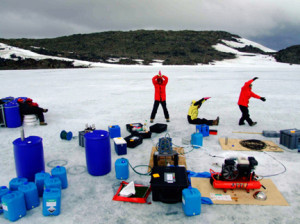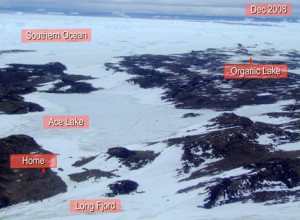WALNUT CREEK, CA—After a genome is sequenced and automatically annotated, researchers often manually review the predicted genes and their functions in order to improve accuracy and coverage across the vast genetic code of the particular target organism or community of organisms. These annotations drive the publication of high-profile science relevant to advancing bioenergy research and our understanding of biogeochemistry—the biological, chemical, physical, and geological processes that regulate our environment.
Scientists at the U.S. Department of Energy (DOE) Joint Genome Institute (JGI) and the Biological Data Management and Technology Center (BDMTC) at Lawrence Berkeley National Laboratory have launched the Expert Review (ER) version of the Integrated Microbial Genomes (IMG) system. IMG ER supports and enhances the review and revision of annotations for both publicly available genome datasets and those newly released from private institutions.
“IMG ER provides scientists with curation tools that improve the annotations of microbial genomes in the context of IMG’s comprehensive collection of genomes,” said Nikos Kyrpides, head of DOE JGI’s Genome Biology Program. “As one of the leading microbial genome sequencing centers in the world, a core mission of the DOE JGI is to ensure the genome sequence data it makes publicly available is high quality.”
The IMG system contains a rich collection of genomes from all three domains of life: as of April 2009, IMG included 1,284 bacterial, 59 archaeal, 49 eukaryotic genomes, as well as 2,524 viruses and 924 plasmids. IMG and its companion metagenome system, IMG/M, have been cited in over 200 publications and have been used in the analysis of dozen of genomes and metagenomes.
IMG ER curation tools allow detecting and then correcting annotation problems, such as genes missed by gene prediction pipelines or genes without an associated function. Over the past year, IMG ER was used for reviewing the annotations of over 150 microbial genomes.

Antarctic expeditioners stretch after unloading their gear at Ace Lake and mark their arrival at their destination.
Photo courtesy of Rick Cavicchioli (University of New South Wales, Australia.)
Most recently, IMG ER was used in research published online April 30 in the International Society for Microbial Ecology (ISME) Journal, by a team led by Rick Cavicchioli at the University of New South Wales, in Sydney, Australia. They announced the completion of a comprehensive manual curation of the Methanococcoides burtonii genome. Anomalies found while combing through nearly 3,000 genes were corrected and recorded with IMG ER, leading to an overall greatly improved quality of the functional annotations.
M. burtonii was isolated from Ace Lake in the Vestfold Hills region of Antarctica and serves as a model organism used to study the molecular mechanisms of cold adaptation.
Roughly three quarters of the planet consists of extremely cold environments where temperatures hover around five degrees Celsius. Some of the microorganisms that have adapted to these conditions include methane-producing organisms (methanogens) that are capable of making significant contributions to global carbon emissions.
“Understanding how methanogens in cold environments respond to changes in temperature is important,” said Cavicchioli. “Doing so will not only help to forecast the levels of associated carbon emissions, but provides opportunities for determining effective ways of harnessing methane as an energy source — understanding the enzymes and processes associated with growth and survival in the cold provides real opportunities for bioenergy and biotechnological innovation.”

Isolated from an Antarctic lake and used to study cold adaptation in archaea,
M. burtonii cells are imaged with a scanning electronic microscope.
Photo: Dominic Burg, Cavicchioli Lab
Polar environments are very sensitive to changes in global temperature, and play critical roles in maintaining microbial processes that are essential for the health of the world’s ecosystems — yet very little is known about polar microorganisms. Lakes in the Vestfold Hills are unique ecosystems that were once connected to the ocean. As the lakes were cut off several thousand years ago, they represent a time capsule for studying the evolution of marine microorganisms.
M. burtonii was the first formally characterized organism of its class capable of growth and reproduction in such cold temperatures. As a model, its characterization has broad implications for other cold adapted organisms that play critical roles in biogeochemical processes such as soil and ocean nitrification.

Antarctic overview taken December 2008 showing Ace Lake in the center with the Long Fjord (marked by the red shelter) that connects to the ocean in the foreground, and the main Southern Ocean with icebergs in the background.
Photo courtesy of Rick Cavicchioli (University of New South Wales, Australia.)
Victor Markowitz, head of BDMTC, said that Cavicchioli’s research team was one of the first groups that started using IMG ER for reviewing genome annotations. “Cavicchioli and his colleagues used our system while it was still in development and their early experience with its tools and valuable feedback helped expand IMG ER’s capabilities.”
The IMG ER system can be accessed at http://img.jgi.doe.gov/er. First-time users need to request an account first at http://img.jgi.doe.gov/request. Upon submission of their genomes, users have password-protected access to their genomes and annotations. Subsequently, genomes become publicly available and are submitted to Genbank.
The U.S. Department of Energy Joint Genome Institute, supported by DOE’s Office of Science, is committed to advancing genomics in support of DOE missions related to clean energy generation and environmental characterization and cleanup. DOE JGI, headquartered in Walnut Creek, Calif., provides integrated high-throughput sequencing and computational analysis that enable systems-based scientific approaches to these challenges.